Clarinet Embouchure -- Free Online Clarinet Lesson 1A
Clarinet Embouchure definitions and detailed instructions.
Definitions of Embouchure
Embouchure – The placement of the lips, facial muscles, and jaw in the playing of wind instruments....The New Harvard Dictionary of Music
Embouchure – The position and use of the lips, tongue, and teeth in playing a wind instrumen....Webster’s Ninth New Collegiate Dictionary
Embouchure – The positioning and shaping of the mouth, lips, and tongue in order to play wind instruments with good tone, true pitch, and proper attack....Harper’s Dictionary of Music
Embouchure – The adjustment of a player’s mouth to such a mouthpiece....Dictionary.com The Clarinet Embouchure is very simple. Here are the instructions:
1. Put the clarinet in your mouth.
2. Blow
Simple, right? Well, not that simple. Anyone can sit down in front of a piano, place a finger on a key and make a sound. This is the same with a guitar or a percussion instrument. This is not saying those instruments are easy, however, clarinet is different in that, hand it to a complete novice, and they will either not make a sound or make a horrible sound.
CYBER MONDAY 2025 CLARINET DEALS
Get 5% off a CLARINET, MOUTHPIECES, REEDS OR EVEN NEW MUSIC CAREER TRAINING
This is a special Clarinet-Now.com code for a limited time: CHRISTOPHERJONE
So, therefore, more instructions for the clarinet mouth formation are offered below.
As there are numerous descriptions of the clarinet embouchure on the internet, in your method books, in music journals and from your clarinet teacher or band director, read them all and listen to your teachers.
If you do not understand one description entirely, perhaps another perspective will give you a better understanding of it. Getting the embouchure formed correctly at the earliest possible time is very important for success on clarinet.
FIND A MIRROR, AND FOLLOW
THESE INSTRUCTIONS FOR THE
CLARINET EMBOUCHURE
1. Flatten your bottom lip and make sure the red part of your lip is over the ridge of your bottom teeth. (Pretend you are putting chap-stick on the lip). Avoid having the red part of your lip all on the inside of your teeth (or outside).
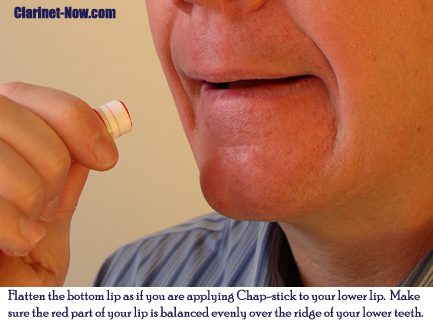
2. Along with the flattened lower lip, also notice your chin is flat or pointed as well. Do not allow strawberries or raspberries to form at the end of the chin. This berry motion has your chin squeezing in an upwards direction. Toning-up or flattening the chin has the skin of your chin moving in a downward position.
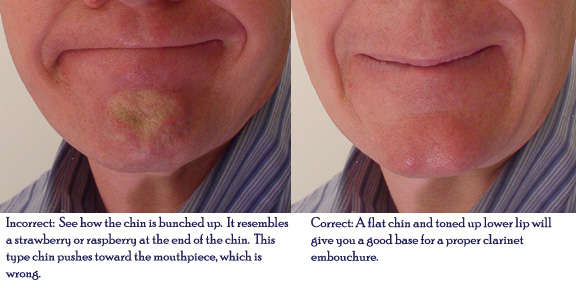
3. Place the clarinet mouthpiece in your mouth (reed down on the lower lip if you are a beginner). Set the reed on your lower lip and let it anchor down the flat, red part of the lip and keep the chin flat. Bring the top teeth down onto the top of the mouthpiece

4. Bite down with the top teeth onto the mouthpiece putting 1/4 inch of the mouthpiece into your mouth. Close your mouth around the mouthpiece like a drawstring.
If you were to make vowel sounds with your mouth, you would start with Eeee and slowly change the mouth to Oooo or Uuuu. Therefore, try this, say EeeeOooo. Notice how round your mouth is. The top lip, corners, and bottom lip should all have equal pressure on the mouthpiece/reed. Another way to think about the top lip is to say Rrrr like a dog growling.
Now, close off the lips so air can only blow into the mouthpiece. Keep the chin flat.
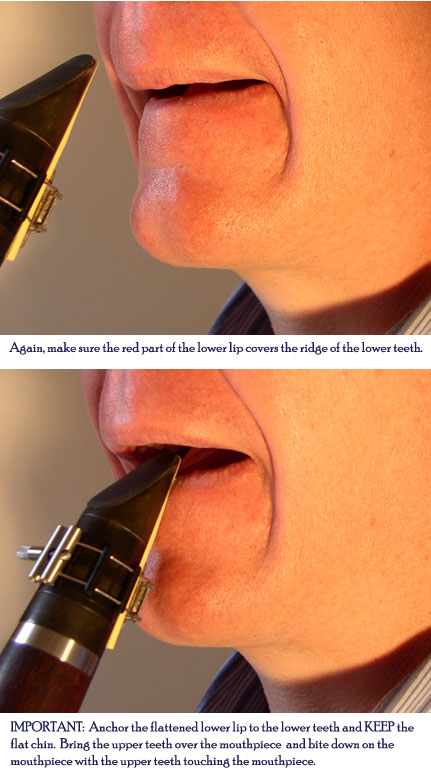
5. As you close your mouth and seal it, pull the chin down and make the skin between your chin and lower lip stretch. (Be careful NOT to open up the pressure of the bite. This is a common mistake and misunderstanding). Now, with your right hand (under the thumbrest) place some pressure against the upper teeth.
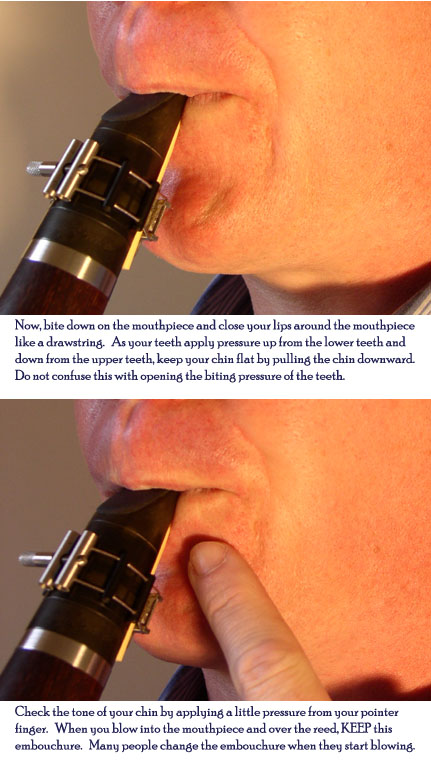
6. BLOW – when breathing, only use the corners of your mouth to take air into your lungs. Keep the same pressure and do not interrupt your flat chin to do this. Many students completely open their mouth to breath and the most efficient way to breath is to use the corners of your mouth.
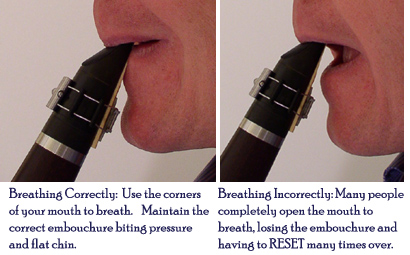
Now, it is very difficult to write out the instructions for the correct clarinet embouchure without including all the incorrect, poor clarinet embouchure habits.
Again, use your mirror and try to troubleshoot your poor embouchure habits by visiting the Clarinet-Now.com page on poor clarinet embouchure.

